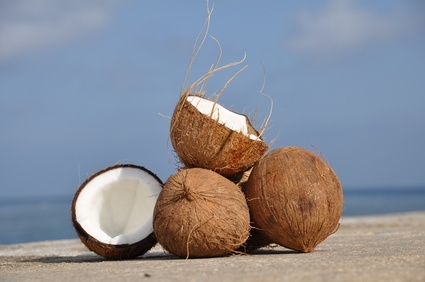My earliest memory of eating coconut meat and drinking fresh coconut water is when I was very young during family summer holidays in Spain. Every day on the beach the same old Spanish man would come carrying his heavy load of fresh coconuts. Wielding a huge machete he would split a coconut in half and remove the deliciously sweet crunchy white meat which we then happily devoured. Maybe that is part of why I love coconuts so much. They remind me of sunshine, blue skies and happy times.
There are several other good reasons to love coconuts. This I found out much later in life and when I did, it only added to my coconut passion. Here is a list of coconut fun facts, health benefits and a link to some delicious recipes.
- A coconut is the large, fibrous, one-seeded drupe (which is a fruit with a hard, stony covering enclosing the seed) of the coconut palm.
- It is also called the “Tree of Life”, “Tree of Abundance” or “King of Trees” among other things as every bit of the coconut can be used: to nourish the body, as fuel, to make utensils, musical instruments, etc.
- In Vedic tradition (the ancient Indian spiritual knowledge tradition) the coconut is considered to be a divine plant, used in sacred ceremonies.
- Ayurveda divides the life of a coconut into three stages, each of which has its own properties*:
1. Baal: tender – or baby coconut
90 – 95% of it is water, considered to be the most pure and healing liquid with a cooling and life-restoring capacity. It is said to repair the gastrointestinal tract and cleanse the urinary tract.
Coconut water is a natural source of electrolytes that helps hydrate and replenish the body’s minerals, especially important during and after exercise and other cases where the body has lost a lot of fluids.
This is now a well-known fact around the world resulting in a huge increase in the sale of packaged coconut water. There is in my opinion no better way to have coconut water then fresh from the coconut. But then again I am lucky enough to live in a place where this is possible.. This is a picture of our coconut vendor down the road.
2. Madhyam: half-mature coconut
Contains water and some soft pulp. It has the same healing properties as the baby coconut but has more carbohydrates, protein, minerals, phosphorus and vitamins and is therefore considered to be even better then the baby coconut according to ayurveda.
So don’t just drink the liquid. Scoop out the pulp and eat it for extra benefits. One of my favorite breakfasts is a porridge made of the water and pulp of a “madhyam” coconut and fresh fruits. Check it out here.
3. Pakva: fully mature coconut
This coconut contains little water and hard flesh. It is, according to ayurvedic wisdom, harder to digest and therefore beneficial in smaller quantities.
This is the part of the coconut that is used to make coconut milk, cream, oil, desiccated coconut and heavenly coconut butter. Check out the recipe for that here.
Coconut oil deserves a special mention here. For a long time it was thought to be one of the “evil” fats because of its high saturated fat content. I find that when I talk to people many still believe this to be true. Fortunately it isn’t and plenty of research studies have shown coconut oil’s amazing benefits. It is now well-known to be one of the best oils to cook with because of its high heating point.
Coconut oil contains Medium Chain Triglycerides (for more on this, please read my article “The Truth About Fat”). This is the type of fat found in mother’s milk. It is easy to digest and high in lauric acid which has anti-bacterial, anti-viral and anti-oxidant properties.
Instead of making you fat, it helps boost your metabolism and provides an immediate source of energy instead of storing it.
Recipes:
Resources:


